The ARG1-LIKE2 gene of Arabidopsis functions in a gravity signal transduction pathway that is genetically distinct from the PGM pathway
- PMID: 12970478
- PMCID: PMC196584
- DOI: 10.1104/pp.103.023358
The ARG1-LIKE2 gene of Arabidopsis functions in a gravity signal transduction pathway that is genetically distinct from the PGM pathway
Abstract
The arl2 mutants of Arabidopsis display altered root and hypocotyl gravitropism, whereas their inflorescence stems are fully gravitropic. Interestingly, mutant roots respond like the wild type to phytohormones and an inhibitor of polar auxin transport. Also, their cap columella cells accumulate starch similarly to wild-type cells, and mutant hypocotyls display strong phototropic responses to lateral light stimulation. The ARL2 gene encodes a DnaJ-like protein similar to ARG1, another protein previously implicated in gravity signal transduction in Arabidopsis seedlings. ARL2 is expressed at low levels in all organs of seedlings and plants. arl2-1 arg1-2 double mutant roots display kinetics of gravitropism similar to those of single mutants. However, double mutants carrying both arl2-1 and pgm-1 (a mutation in the starch-biosynthetic gene PHOSPHOGLUCOMUTASE) at the homozygous state display a more pronounced root gravitropic defect than the single mutants. On the other hand, seedlings with a null mutation in ARL1, a paralog of ARG1 and ARL2, behave similarly to the wild type in gravitropism and other related assays. Taken together, the results suggest that ARG1 and ARL2 function in the same gravity signal transduction pathway in the hypocotyl and root of Arabidopsis seedlings, distinct from the pathway involving PGM.
Figures
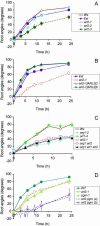
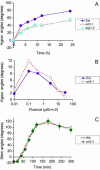
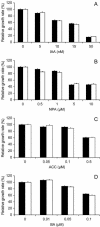
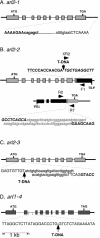


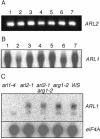
Similar articles
-
ARL2, ARG1 and PIN3 define a gravity signal transduction pathway in root statocytes.Plant J. 2008 Jan;53(2):380-92. doi: 10.1111/j.1365-313X.2007.03351.x. Epub 2007 Nov 28. Plant J. 2008. PMID: 18047472
-
A role for the TOC complex in Arabidopsis root gravitropism.Plant Physiol. 2009 Apr;149(4):1896-905. doi: 10.1104/pp.109.135301. Epub 2009 Feb 11. Plant Physiol. 2009. PMID: 19211693 Free PMC article.
-
What is the threshold amount of starch necessary for full gravitropic sensitivity?Adv Space Res. 1998;21(8-9):1197-202. doi: 10.1016/s0273-1177(97)00635-2. Adv Space Res. 1998. PMID: 11541372
-
Root gravitropism: a complex response to a simple stimulus?Trends Plant Sci. 1999 Oct;4(10):407-12. doi: 10.1016/s1360-1385(99)01472-7. Trends Plant Sci. 1999. PMID: 10498965 Review.
-
The endodermis and shoot gravitropism.Trends Plant Sci. 1999 Mar 1;4(3):103-7. doi: 10.1016/s1360-1385(99)01376-x. Trends Plant Sci. 1999. PMID: 10322541 Review.
Cited by
-
Joining forces: the interface of gravitropism and plastid protein import.Plant Signal Behav. 2009 Oct;4(10):933-41. doi: 10.4161/psb.4.10.9470. Epub 2009 Oct 30. Plant Signal Behav. 2009. PMID: 19826232 Free PMC article.
-
Hormonal interactions during root tropic growth: hydrotropism versus gravitropism.Plant Mol Biol. 2009 Mar;69(4):489-502. doi: 10.1007/s11103-008-9438-x. Epub 2008 Dec 16. Plant Mol Biol. 2009. PMID: 19083152 Review.
-
Molecular mechanism of brassinosteroids involved in root gravity response based on transcriptome analysis.BMC Plant Biol. 2024 Jun 1;24(1):485. doi: 10.1186/s12870-024-05174-6. BMC Plant Biol. 2024. PMID: 38822229 Free PMC article.
-
Molecular mechanisms of gravity perception and signal transduction in plants.Protoplasma. 2016 Jul;253(4):987-1004. doi: 10.1007/s00709-015-0859-5. Epub 2015 Jul 28. Protoplasma. 2016. PMID: 26215561 Review.
-
Strategies of seedlings to overcome their sessile nature: auxin in mobility control.Front Plant Sci. 2015 Apr 14;6:218. doi: 10.3389/fpls.2015.00218. eCollection 2015. Front Plant Sci. 2015. PMID: 25926839 Free PMC article. Review.
References
-
- Arabidopsis Genome Initiative (2000) Analysis of the genome sequence of the flowering plant Arabidopsis thaliana. Nature 408: 796-814 - PubMed
-
- Ausubel FM, Brent R, Kingston RE, Moore DD, Seidman JG, Smith JA, Struhl K (1994) Current Protocols in Molecular Biology: Updates 1994-2002. John Wiley and Sons, New York.
-
- Bell CJ, Ecker JR (1994) Assignment of 30 microsatellite loci to the linkage map of Arabidopsis. Genomics 19: 137-144 - PubMed
-
- Bennett MJ, Marchant A, Green HG, May ST, Ward SP, Millner PA, Walker AR, Schulz B, Feldmann KA (1996) Arabidopsis AUX1 gene: a permease-like regulator of root gravitropism. Science 273: 948-950 - PubMed
Publication types
MeSH terms
Substances
Associated data
- Actions
- Actions
LinkOut - more resources
Full Text Sources
Other Literature Sources
Molecular Biology Databases
Research Materials
Miscellaneous

